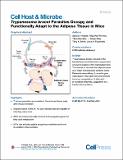Trypanosoma brucei parasites occupy and functionally adapt to the adipose tissue in mice
Date
08/06/2016Author
Grant ID
602773
093228/Z/10/Z
MR/M020118/1
Keywords
Metadata
Show full item recordAbstract
Trypanosoma brucei is an extracellular parasite that causes sleeping sickness. In mammalian hosts, trypanosomes are thought to exist in two major niches: early in infection, they populate the blood; later, they breach the blood-brain barrier. Working with a well-established mouse model, we discovered that adipose tissue constitutes a third major reservoir for T. brucei. Parasites from adipose tissue, here termed adipose tissue forms (ATFs), can replicate and were capable of infecting a naive animal. ATFs were transcriptionally distinct from bloodstream forms, and the genes upregulated included putative fatty acid β-oxidation enzymes. Consistent with this, ATFs were able to utilize exogenous myristate and form β-oxidation intermediates, suggesting that ATF parasites can use fatty acids as an external carbon source. These findings identify the adipose tissue as a niche for T. brucei during its mammalian life cycle and could potentially explain the weight loss associated with sleeping sickness.
Citation
Trindade , S , Rijo-Ferreira , F , Carvalho , T , Pinto-Neves , D , Guegan , F , Aresta-Branco , F , Bento , F , Young , S A , Pinto , A , Van Den Abbeele , J , Ribeiro , RM , Dias , S , Smith , T K & Figueiredo , LM 2016 , ' Trypanosoma brucei parasites occupy and functionally adapt to the adipose tissue in mice ' , Cell Host & Microbe , vol. 19 , no. 6 , pp. 837-848 . https://doi.org/10.1016/j.chom.2016.05.002
Publication
Cell Host & Microbe
Status
Peer reviewed
ISSN
1931-3128Type
Journal article
Description
This work was supported by 55007419 (HHMI) and 2151 (EMBO) to L.M.F., D.P.-N., F.B., and F.G.; FCT fellowships to S.T., F.R.-F., and F.A.-B. (SFRH/BPD/89833/2012, SFRH/BD/51286/2010, and SFRH/BD/80718/2011, respectively); Wellcome Trust grant (093228), MRC MR/M020118/1, and European Community Seventh Framework Programme under grant agreement No. 602773 (Project KINDRED) to S.A.Y. and T.K.S.; and PAI 7/41 (Belspo) and ERC-NANOSYM to J.V.D.A.Collections
Items in the St Andrews Research Repository are protected by copyright, with all rights reserved, unless otherwise indicated.

